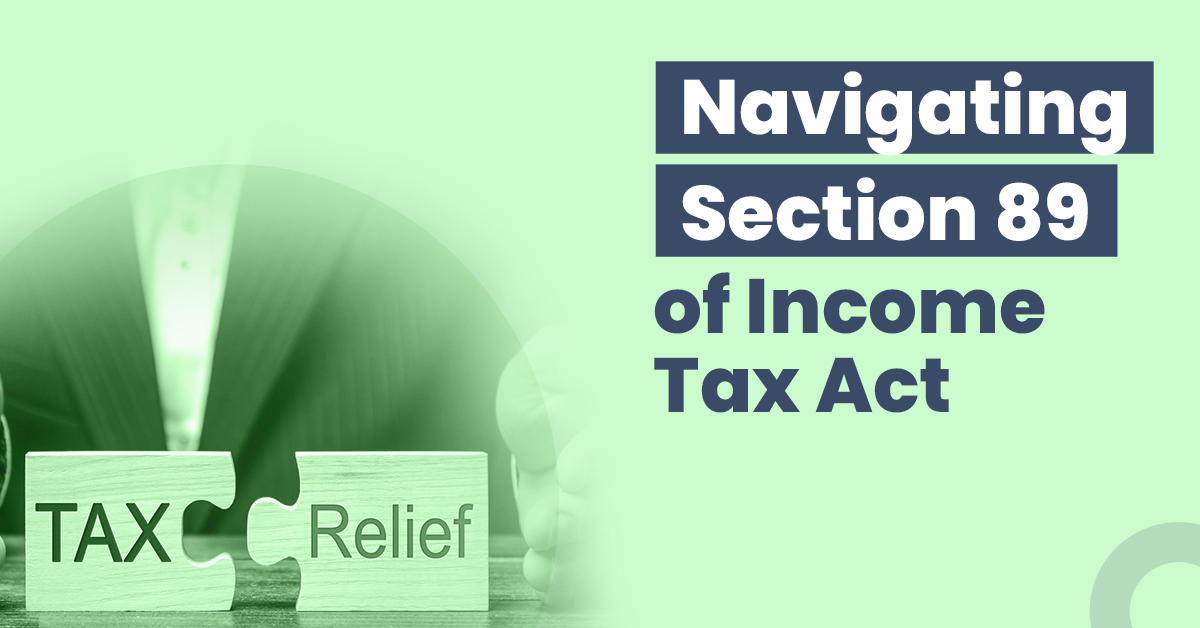Navigating Section 89 of the Income Tax Act: How to Claim Relief?


Aditya is a salaried employee, and his employer recently sent him a large amount of back pay. He is now worried about how this will affect his taxes and whether he will have to pay more than he should. He’s lucky that he finds out about Section 89 of the Income Tax Act, which relieves people in his situation.
However, not everyone can claim relief under this section. Understanding the eligibility criteria and the process of claiming relief is vital. Read on to learn more about Section 89 and who can get relief through it.
What is Section 89 of the Income Tax Act?
Section 89 is a provision that helps people who get their salary or similar income paid later or in advance by adjusting the total income to a more favourable level.
If a person gets a salary in advance or later, or if they get a salary for more than 12 months in a fiscal year, or if they get a payment that is considered a profit in place of a salary, their total income may be taxed at a higher rate.
Section 89 lets people ask the Assessing Officer for relief in the form of a set amount so that this doesn’t happen. This means that the Assessing Officer will change the person’s total income so that it is taxed at a better rate for them.
But this relief isn’t available to people who have received or will receive money due to voluntary retirement or the end of their service as part of voluntary retirement schemes. It also doesn’t apply to people who have used Clause (10C) of Section 10 to get an exemption for any other assessment year.
Read on to learn more about individuals who can claim relief as per the provisions of this Act in the next section.
Who can claim relief under Section 89?
This relief can be claimed on any of the following types of income received during a given year:
- Salary received later or in advance.
- Premature withdrawal from a Provident Fund.
- Gratuity.
- The commuted value of a pension.
- Arrears of family pension, and
- Compensation for the termination of employment.
People can get tax breaks under Section 89 if they meet the following conditions:
- They get a salary-like amount paid to them early or in advance.
- They get a salary for more than 12 months in a single financial year or a profit payment in lieu of their salary.
- Likewise, they get the amount in the form of a family pension, which is paid to them in arrears. As a result, their total income is counted at a higher rate than it would have been otherwise.
It’s important to remember that Section 89 relief isn’t available to people who have received or will receive any amount on voluntary retirement or the termination of their service as part of voluntary retirement schemes.
What documents are required?
Here is a list of the documents required to claim this relief:
- Form 10E: This form you need to fill out to give information about your income under Section 192(2A) and ask for help with salary arrears under this section.
- Salary slips and certificates from your employer: These papers are needed to back up the claim for relief and show that the arrears have been paid.
- Proof of taxes paid in a foreign country: If the arrears came from a foreign employer, Section 89(1) also requires proof of taxes paid in that foreign country.
- PAN Card: A Permanent Account Number (PAN) card is needed to prove your identity when you file your taxes.
- Bank account details: The taxpayer’s bank details are also required to claim relief, as the refund will be credited to the account.
What is the process for claiming relief under this section?
Relief under Section 89 can be claimed by filling out Form 10E on the official Income Tax website. It is recommended that Form 10E be submitted before filing the tax return.
Here are some steps that you must follow when filling out Form 10E:
- Log into the Income Tax e-Filing website using your login credentials.
- Once logged in, click on the “e-File” tab, and a drop-down menu will appear. Select “Income Tax Forms”.
- Choose “FORM NO. 10E- form for relief u/s 89” from the drop-down menu.
- Select the “Assessment Year” for which you are filing the relief and in “Submission Mode”, select “Prepare and Submit Online”.
- A new page will open for FORM NO. 10E, where you will need to enter the required details.
- While filling out the form, you can click on “Save Draft” to save your progress and click on “Preview & Submit” after completing the form.
The person must have proof of the arrears, proof that taxes were paid on the previous year, and proof that he or she filed a return of income for the year in which the early payment was made.
Common mistakes to avoid
Here are some of the common mistakes that must be avoided while claiming relief under section 89 of the Income Tax Act:
Failing to file Form 10E
Form 10E is an important document that must be filled out and sent in online before the Income Tax Return can be filed. The Income Tax department (ITD) will notify taxpayers who did not file Form 10E during the last financial year. The return will not be processed until the form is sent in.
Not choosing the correct assessment year
When claiming relief on arrears, it is essential to choose the right assessment year in which the arrears were received. For example, if arrears were paid in FY 2017-18, AY 2018-19 should be the assessment year.
Not providing all the required details in Form 10E
Form 10E has information about an employee’s total income and any back pay they got. It’s important to carefully fill out the form and include all the needed information and attachments.
Not providing supporting documents
Along with Form 10E, it is important to include supporting documents like pay stubs and employer certificates to back up the claim for relief.
Not understanding the exemptions and exemptions limits
Before asking for help under Section 89, it’s essential to know the Income Tax Act’s exemptions and exemption limits to avoid confusion and mistakes.
Not understanding the rules of relief
Before asking for relief under section 89, it’s essential to know how the rules work. Make sure you know how to figure out how much relief you can get under Section 89.
Not claiming relief in time
It is vital to ask for relief under Section 89 as soon as possible. You could lose benefits if you wait too long to ask for relief.
Understanding with an Example
Let’s try to understand this with the help of a situation discussed earlier. Aditya receives a salary of ₹ 8,00,000 in the financial year 2022-23, which includes ₹ 1,00,000 as arrears for the previous financial year. To calculate the tax relief under Section 89(1) on the salary arrears, Aditya must follow these steps:
Step 1
He should first calculate the tax liability on the total income received for the current financial year. This includes any extra salary received in arrears.
Tax payable on ₹ 8,00,000 including arrears of ₹ 1,00,000 = ₹ 2,00,000
Step 2
Then calculate the tax liability on the total income received for the current financial year, excluding any extra salary received in arrears.
Tax payable on ₹ 7,00,000 = ₹ 1,50,000
Step 3
Then find the difference between the amount in Step 2 and Step 1.
₹ 2,00,000 – ₹ 1,50,000 = ₹ 50,000
Step 4
He should now calculate the tax liability on the total income, excluding arrears, for the financial year to which the arrears relate.
Tax payable on ₹ 7,00,000 for financial year 2022-23 = ₹ 1,40,000
Step 5
The next step is calculating the tax liability on the total income, including arrears, for the financial year to which the arrears relate.
Tax payable on ₹ 8,00,000 for financial year 2022-23 = ₹ 1,60,000
Step 6
Then find the difference between the amount in Step 4 and Step 5.
₹ 1,60,000 – ₹ 1,40,000 = ₹ 20,000
Step 7
Finally, Aditya needs to compare the amount from Step 3 and Step 6. If the calculation from Step 3 is greater than the calculation from Step 6, the excess amount is the tax relief that will be allowed to you.
₹ 50,000 – INR 20,000 = ₹ 30,000
Conclusion
Claiming relief under Section 89 of the Income Tax Act is essential for salaried individuals who have received excess income or income from the previous year in the current year. All the steps that must be followed have been detailed above. In case of any doubts, the expert opinion must be sought.
FAQs
Can I fill out Form 10E after filing my tax return?
You can fill out Form 10 E when you file your income tax returns.
What are arrears benefits?
Arrears benefits refer to unpaid amounts that are owed to an employee for a past period of time. It includes any forms of compensation that were due to an employee but were not paid when they were earned. Arrears benefits can also include health insurance, retirement plans, or other employee perks.
Are arrears taxable?
Arrears of salary are considered taxable income.
Can I claim HRA arrears?
HRA arrears can be claimed under section 89 because it is a part of salary arrears.
What is Form 10E?
Form 10E is a form required by the ITD to claim relief under Section 89(1). It is used to furnish details of the income received and the relief claimed. It must be filed online before filing the Income Tax Return.
Do I need to attach a copy of Form 10E while filing my tax return?
Before you file your income tax return, you must fill out Form 10E. So there is no need to include it with the tax return. On the tax return form, you will need to write down the specifics of the relief you are claiming under Section 89(1). Also include Form 10E’s reference number. This will make it easier for the ITD to check your claim for relief. Keep a copy of Form 10E in case you need it in the future.
How can I save tax on my salary?
There are many ways to save money on taxes on your salary:
Invest in tax-saving options like the Public Provident Fund (PPF), the National Savings Certificate (NSC), the Equity-Linked Savings Scheme (ELSS), and so on.
Use Section 80C to get a tax break. This section lets you deduct investments in certain instruments and expenses like life insurance premiums, tuition fees, and so on.
Section 80D lets you deduct the cost of health insurance premiums paid for yourself, your spouse, and your children.
Use Section 80E to get a tax break for interest on student loans.
If you don’t get HRA from your employer, you can deduct the rent you paid under Section 80GG.
Use Section 80G to get tax breaks for giving to charity.
Use the New Tax Regime and give up your deductions and exemptions to pay less in taxes.




